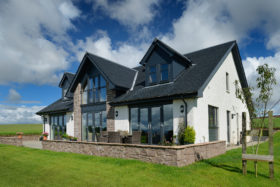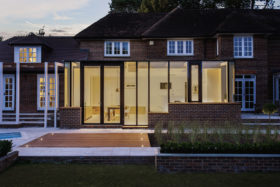
Learn from the experts TONIGHT with our online training course!
Use the code BUILD for 20% off
Learn from the experts TONIGHT with our online training course!
Use the code BUILD for 20% offIf you’re looking for an intuitive, quick structural system with impressive energy performance, then insulated concrete formwork (ICF) could be a great choice for your self build project.
Sometimes referred to as LEGO for adults, ICF is a straightforward building method that can get you to weathertight stage very fast.
What’s more, it lends itself to pretty much any style of house design, and quality is built-in thanks to its impressive thermal and acoustic properties.
Here’s what you need to know if you’re considering ICF for your self build home.
ICF is based on hollow block or sheet components, usually made of expanded polystyrene (EPS), fastened together with metal or plastic connectors.
The panels or blocks feature an interlocking profile, so they can be stacked without bonding materials to provide a formwork system into which concrete is pumped.
Steel reinforcement is inserted into the cavities, to the structural engineer’s design. The formwork is then braced and aligned, ready to be filled with poured concrete.
Walls are generally constructed to first floor level before filling with concrete, letting it dry and going up to next storey or roof.
Considering different build systems?Once you have a plot, the next key decision is which build route is best for your project. Timber frame, ICF, brick, masonry, hemp, SIPs, CLT or steel frame? All have their benefits and downsides. At Build It Live you can speak to experts who specialise in building with these different systems and who can help you choose the best choice for you. Explore all the options, all in one place – only at Build It Live. Build It Live takes place three times a year in Kent, Oxfordshire and Exeter. The next show will be on 22nd and 23rd February 2025 in Maidstone, Kent. Claim a pair of free tickets today and start planning your visit. |
The ready-mix concrete is delivered on a truck and poured in lifts, with the crew gradually moving around the building. This minimises pressure on the ties and bracing, thus reducing the chance of Grand Designs-style blow-outs.
The concrete must be carefully directed and vibrated to prevent voids forming. Particular attention to detail is needed around structural openings and areas such as gables to ensure a full fill, for maximum strength and airtightness.
Once the pour is complete, the ICF remains in place to provide a robust layer of thermal insulation – one that will last for the lifetime of the building.
The formwork bestows fantastic U-values (a measure of heat loss) ranging from around 0.30 W/m2K right down to around 0.11 W/m2K. So you can enjoy a highly efficient home that easily surpasses Building Regulations standards – meaning lower bills and less energy in use.
ICF structures also offer very good airtightness as standard, as the concrete pour and insulating formwork combine to create a highly sealed house shell. This helps to reduce heat loss even more.
Different thicknesses of ICF block, with varying insulation depths, are available to help you achieve your target thermal performance (including Passivhaus standards).
Another benefit, and a big plus in this age of environmental awareness, is that the system only produces a tiny amount of waste in construction. Any offcuts of polystyrene can be re-used elsewhere, on or off the build, and you can order the ready-mixed concrete to exact volume requirements.
Because ICF is such a heavyweight formwork, it also provides fantastic acoustic properties. “ICF homes are incredibly quiet”, says Chris Stride, chair of the Insulating Concrete Formwork Association (ICFA)
“Heating and cooling bills will be minimal, and because you have an air quality system, they never feel stale. It’s almost like they cuddle you!”
ICF is fast to build with and requires less in the way of traditional building skills when compared to brick-and-block and even timber frame projects.
In most cases, the formwork for a four-room ground floor can be erected in just a couple of days. Your contractor would then spend a few days bracing the walls and any structural openings.
The concrete pour for a whole storey can usually be completed in less than a day.
Only a small team of semi skilled (to around NVQ level 2) operatives is needed to put up the basic structure – which will save money on time and labour.
Most ICF firms in the UK run training courses to bring you up to the right level of competency to help construct the house yourself.
And, as the insulation and structure are all completed in a single process, the homeowner inevitably saves time and expense on this, too.
Inspiring ICF Self BuildTerry Brown-Waite and his wife Olwen wanted to take a hands-on approach to designing and building their energy-efficient and futureproof home. The ultra-modern house sits at the end of the road filmed in Grand Designs: The Street and was one of the first properties to be completed on Graven Hill’s pioneering self and custom build development. All hands on deckAfter weighing up different systems, Terry and Olwen knew only one would deliver all their requirements. Opting for ICF enabled them to get stuck in throughout the process. Blue House is the ultimate hands-on self build, with Terry taking on the bulk of the construction work, thanks to the easy-to-use nature of Durisol’s blocks. This gave him the satisfaction of having built a house from scratch, and also meant the couple saved significantly on labour costs. Terry was able to manipulate the units on site to fit the irregular shape of their home. “Building with Durisol really was simple,” says Terry. “I had no problem laying the blocks and it was a rapid way to build. |
While it is easy to spot the construction system used on many homes, it is nearly impossible to tell an ICF house from a masonry or timber frame project. This is because the system is ultra flexible design-wise.
The blocks can be used for creating curved walls, arches and irregular angles – you can build in any style, to virtually any dimension.
It’s easy to construct bay windows, large openings for sliding doors and features such as cantilevers, as they can be integrated into the building envelope and internal walls, eliminating the need to specify specialist products.
Case study: Award Winning Energy-Efficient Self BuildThe dramatic design of this Build It Award-winning ICF home incorporates local and traditional materials to reflect the previous derelict farm buildings on the site and blend with the rural landscape. Local architect, Peter Bamber, was commissioned to design a modern, energy efficient family home reflecting the existence of the previous buildings of farm cottage and stone-clad and open barns. In the dramatic design produced, the three elements are apparent, the cottage and barn being connected by the glazed link which is timber clad, reminiscent of the old open barn. Combining the unique design of three different elements, along with the client brief for sustainability, was potentially problematic. The solution, however, was a fabric first approach, specifying solid construction with Wallform ICF for the external walls, and concrete floors. |
The polystyrene blocks or sheets give a uniform and smooth surface that is ready to take most forms of internal and external finish.
Externally you can clad ICF with a myriad of materials. Many ICF homeowners opt for some sort of coloured flexible render, as it works really well and can be applied directly onto the polystyrene.
You can also choose more conventional finishes such as brick slip, stone facade or weatherboarding depending on your design.
Strong and easy to waterproof, ICF is very popular for basements on new build homes, too. In fact, in many cases it’s cheaper for basement builds than other solutions.
Read more: Design Guide to Building with ICF
Although ICF sounds like simplicity itself, there are a few things to bear in mind if you choose the system.
The pour stage is critical – the ready-mix concrete has to be of the right consistency to flow to all parts of the formwork.
The ICF system must also be braced to exacting measurements, or else walls could distort. The concrete has to be poured in slowly and steadily to avoid any risk of the forms bursting open.
FAQ: Insulated Concrete FormworkHow are window openings formed?This will depend on the exact system you choose. The Nudura method uses pre-formed EPS closers that slot into place at the top, bottom and sides to contain the pour (with timber bracing) and maintain the thermal envelope. Alternatives include inserting temporary metal frames. Whichever option you choose, the key is to triple-check everything’s as it should be before the pour, as cutting concrete back after the fact isn’t much fun. What’s the roof made of?ICF is a walling-only system. Most self builders will go for conventional Fink or attic trusses for the roof. You can switch to options such as SIPs (structural insulated panels) up top if you wish, but double-checking your engineer can deal with both elements first; otherwise you could be adding complication. Alternatively, Net-Zero’s whole house shell package can include the use of its own iFoam beams to create a hybrid, pre-insulated roofing solution. What about internal walls?You can use ICF, and it may make sense to for load-bearing internal walls or where you need great sound performance. But the downside is they will be pretty thick – hence to maximise floor space, many people switch to standard blockwork for load-bearing internal structures, and timber studs for partitions. |
Obviously mistakes do happen, but an experienced ICF contractor will be able to resolve any problems.
Adapting the house in the future – adding doors and windows, or moving their position – can be fairly difficult, although not impossible using specialist tools.
As a general guide, an ICF home building project is likely to come in at around 5% more than a typical timber frame home.
As we’ve seen, however, in the right hands insulated concrete formwork can be an extremely quick and efficient system. That can net you significant savings on labour costs.
You can save even more on your build costs if you decide to do some of the work DIY on your ICF project. But remember that, if something goes wrong, it will be up to you to spend the time and money putting it right.
To get an idea of what your home building project might cost, check out Build It’s interactive Build Cost Calculator.


Comments are closed.